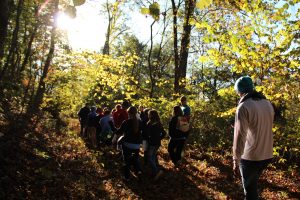
by LaRoy Brandt, Lincoln Memorial University
On October 27th, Lincoln Memorial University (LMU), the Abraham Lincoln Library and Museum, and the Cumberland Mountain Research Center hosted 84 middle school students from various school districts for an event focused on informal science education. The visiting students participated in three interrelated programs that emphasized the unique environmental and human history of Southern Appalachia and the Cumberland Gap. One program emphasized Appalachia Biodiversity Past and Present; a second emphasized the Natural History of Southern Appalachia especially in regards to water; and a third emphasized Human Environmental History of Cumberland Gap Past and Present. All three programs integrated science and history of the Cumberland Gap to reinforce the message that the current state of the environment is the result of past and present interactions between humans and nature.
Prior to the event, seven LMU students participated in day-long “crash courses” that developed their knowledge and skills necessary to develop and deliver the programs that were offered. Taking advantage of LMU faculty expertise, the participating LMU students were trained not only in the art of informal science education through interpretive programming but also the environmental and human histories of the Cumberland Gap region. In turn, the LMU students developed the three programs: 1) Appalachia biodiversity which utilized many of the “stuffed” animals and preserved animal skins from the conservation biology program’s collection to discuss historical changes in biodiversity from pre-European settlement to modern conservation activities, 2) Natural History focused on the importance of water as a force that has influenced land topography and how human activities affect both surface and groundwater (LMU students built three stream tables that provided visiting students a first-hand study of erosion and runoff, and 3) Human Environmental History of Cumberland Gap was emphasized the history of human use of the landscape and tree growth in the region through a nature hike into the mountain area that is the backdrop for the LMU campus. Through the nature hike, LMU students were able to tie all the programs together by recognizing that the local mountains had been clear-cut numerous times to serve a variety of human needs throughout the history of European expansion across North America, and that this history is not only a significant piece of American History, but also crucial to the origin of the LMU campus.
This work was part of a project funded by a sub-award provided by SENCER-ISE through the project Partnership Champions: SENCER ISE and Professional Development Through Mentoring to Enhance Learning Environments (MG-10-15-0071-15A). Partnership Champions is funded by the Institute of Museum and Library Services.
Photograph courtesy of LMU/Nikki Lockhart
